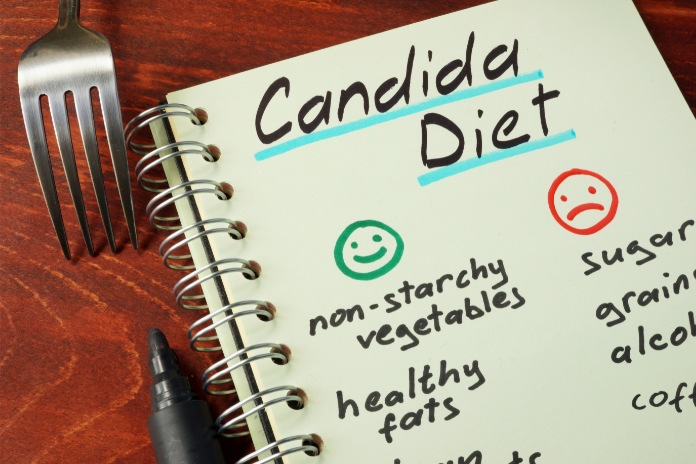Candida diet is suggested to decrease the risk of overgrowth of Candida in the body. Candida is one of the most common types of fungus found in the human body. It usually affects the skin, mouth, vagina, rectum, toenails, and digestive tract. Being harmless in nature, if overgrown, can lead to serious infection. To decrease the risk of overgrowth,
The candida diet requires people to cut down on specific food items. Such as alcohol, sugar, gluten, and certain types of dairy. The candida diet suggests people eat lean proteins, non-starchy vegetables, healthy fats, and probiotics. The diet is also seen to be beneficial to regulate blood sugar levels. It limits foods that increase or spike blood sugar levels in the body. This type of diet is carb restrictive and temporary in nature. Hence it should be carried out only if prescribed by a doctor.
Foods To Consume In The Candida Diet
- Non-starchy vegetables like sprouts, cabbage, cucumber, eggplant, onions, zucchini, tomatoes, asparagus, kale, celery, broccoli.
- Healthy fats like salmon, turkey, sardines, chicken, eggs.
- Low-sugar fruits like limes, berries, lemon (to be consumed in very small portions).
- Gluten-free grains like oat bran, quinoa, millet, and buckwheat.
- Dairy products like plain yogurt, butter, ghee, and organic kefir.
- Herbs and spices like rosemary, oregano, turmeric, salt, cinnamon, black pepper salt, ginger.
- Nuts and seeds like flaxseeds, almonds, sunflower seeds, coconut seeds.
- Non-sugar sweeteners like stevia and xylitol.
- Non-caffeinated beverages like homemade coconut or almond milk. Also water with lemon or lime, filtered water, herbal teas, chicory coffee.
- Condiments like coconut aminos or apple cider vinegar.
Foods To Avoid In The Candida Diet
- Meats like deli and farm-raised meats.
- Grains with gluten like wheat, barley, rye, and spelt.
- High-sugar fruits like raisins, grapes, dates, and mangoes.
- Refined oils and fats like soyabean oil, sunflower oil, margarine, and canola oil.
- Dairy products like cheese, milk, and cream.
- Nuts and seeds like pistachios, peanuts, cashews, and pecans.
- Additives like nitrates or sulfates.
- Beverages like coffee, energy drinks, caffeinated drinks, alcohol, fruit juice, beer, wine.
- Artificial sweeteners like corn syrup, honey, maple syrup, cane sugar, table sugar, agave.
- Condiments like soy sauce, vinegar, ketchup, BBQ sauce, mayonnaise.
The Candida Diet
Before beginning the diet, a candida cleanse is recommended. It is a short-period diet. It helps in alleviating stress on the digestive tract and releases toxins from the body. There are two common ways to carry out the cleansing process. One is by drinking only fluids such as lemon water. Two is by mainly eating vegetables along with a small portion of protein. After the completion of cleansing, the guidelines of the candida diet are to be followed.
There exists no specific or rigid timetable for the diet. Hence it is easy and flexible to follow. Two things to keep in mind when starting with the candida diet. Start slow and know that the diet is short-term. To start slow means by removing compounds such as sugar, gluten, and caffeine one at a time and not all together.
Sample Meal Plan
Monday
- Breakfast: scrambled eggs with tomatoes and avocado as sides.
- Lunch: turkey topped with a salad of greens, cabbage, avocado, broccoli with an olive oil dressing.
- Dinner: stir fry quinoa, steamed vegetables, chicken breast, and coconut aminos.
Tuesday
- Breakfast: yogurt parfait made with plain yogurt along with 25 grams of berries, cinnamon, and almonds.
- Lunch: Thai red curry chicken.
- Dinner: salmon cakes with broccoli on the side and a cup of bone broth.
Wednesday
- Breakfast: turkey and sage sausages with brussels sprouts as siders.
- Lunch: lemon roasted chicken with salad greens.
- Dinner: hamburger patty without a bun. Topped with avocado and steamed vegetables at the side.
Thursday
- Breakfast: vegetable omelet made with spinach, tomatoes, shallots, and eggs.
- Lunch: turkey and sage breakfast sausage along with sauteed cabbage.
- Dinner: coconut chicken curry over quinoa and steamed vegetables.
Friday
- Breakfast: omelet with red peppers, onions, kale, and fried eggs.
- Lunch: turkey meatballs along with a kale salad and millet with ghee on top.
- Dinner: wild-caught salmon seasoned with dill and lemon, along with asparagus at the side.
Saturday
- Breakfast: breakfast muffins (buckwheat) along with chicory coffee.
- Lunch: coconut chicken curry over quinoa and steamed vegetables.
- Dinner: zucchini noodles garnished with raw garlic, chicken, olive oil, and pesto.
Sunday
- Breakfast: smoothie made from kefir, berries, almond butter, coconut, and cinnamon.
- Lunch: salad of hard-boiled eggs, olives, cucumbers, tomatoes, turkey, and olive oil.
- Dinner: fajita bowl made with chicken, cilantro, avocados, peppers, and green salad.
Possible Benefits
- It can aid in weight loss.
- Improves gut functioning.
- It has a positive effect on heart health.
- It reduces inflammation.
- Decreases risk of obesity.
- Regulates blood sugar levels as it restricts sugary foods.
- Improves metabolism.
Possible Downsides
- Limited research into its effectiveness on humans.
- Increased growth of candida in the digestive tract on the consumption of sugar.
- Is difficult to adjust to the diet as it requires cutting down food items that are used for daily consumption.
- Is not considered to be budget-friendly as it requires replacing almost all the basic ingredients.
- The diet is not radical and safe for everyone.
- Feelings of headache, nausea, and fatigue might be experienced.
Enjoyable Recipes
- Whole roasted cauliflower with Indian spices
- Instant pot bone broth
- Easy cauliflower turmeric burgers
- Crockpot curry chicken
- Candida friendly gut-healing keto paleo pancakes
- Candida friendly smoothie
- Asparagus basil salad
- Green eggs
- Crispy coconut almond chicken
- The candida diet safe shamrock shake
Sources:
